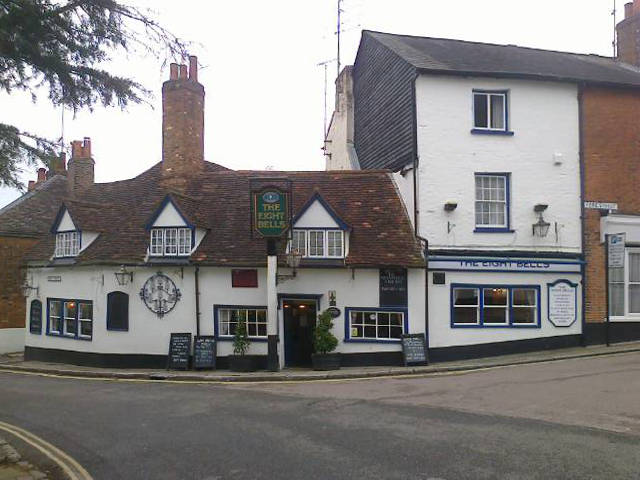
The Eight Bells, Hatfield (north of London).
Although the old inn was built in 1226 and frequented by the notorious eighteenth-century highwayman Dick Turpin, it is now chiefly remembered as the resort of a purely fictional character, Charles Dickens's Bill Sikes, who in Oliver Twist repairs thither after having murdered his mistress Nancy. Charles Dickens stayed at this inn on 27 December 1838. According to Dorothy Eagle and Hilary Carnell, Dickens's third major literary work and first organicly organised novel, Oliver Twist, is associated with three particular settings: the Black Swan Inn near Chertsey Bridge, Surrey; No. 8 Doughty Street, Holborn (where he wrote the novel in serial parts between 1838 and 1839); and The Old Star and Garter Hotel, Richmond Hill, near which he stayed stayed in a rented cottage and swam daily while writing the novel. However, the site generally acknowledged as being the inn to which Bill Sikes repairs after murdering his mistress, Nancy, suspecting that she is a police informant, is a local pub at Hatfield in Hertfordshire.


In Part 21 (January 1839), Chapter 48, "The Flight of Sikes," the housebreaker and his dog travel through Islington, up Highgate Hill and down the other side, skirt Caen Wood, cross Hampstead Heath, and arrive at evening at "a small public-house" in the quiet village of Hatfield — undoubtedly the Eight Bells, which already had associations with the notorious highwayman Dick Turpin. After taking a pint and paying his bill, Sikes panicks when Harry the peddler, obviously a local character, insists upon trying to remove the stain (which he speculates may be a blood-stain) upon Bill's hat: "The man got no further, for Sikes with a hideous imprecation overthrew the table, and tearing the hat from him, burst out of the house." Later in his career, Dickens utilized the village again in "Mrs. Lirriper's Legacy" (in "The Extra Christmas Number" of All the Year Round in 1864), in which the grand old lady is buried in the churchyard at Hatfield.
The photograph at top and below right are by Stuart Eagles. The photograph in the second row, which was taken in 1976, and the text, are by Philip V. Allingham. You may use these images without prior permission for any scholarly or educational purpose as long as you (1) credit the photographer and (2) link your document to this URL in a web document or cite the Victorian Web in a print one.
References
Eagle, Dorothy, and Hilary. The Oxford Illustrated Literary Guide to Great Britain and Ireland. Oxford: Oxford U. P., 1980.
Created October 2006
Last modified April 14, 2019